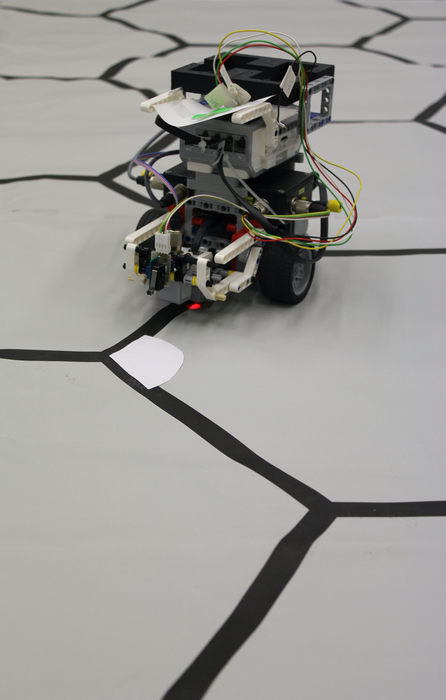The working system of the human brain is very different from a computer. The brain works with biological cells and electrical impulses whereas a computer uses silicon-based transistors.
 A toy robot learns to pass a maze through an organic neuromorphic circuit. Image Credit: Max Planck Institute for Polymer Research.
A toy robot learns to pass a maze through an organic neuromorphic circuit. Image Credit: Max Planck Institute for Polymer Research.
Paschalis Gkoupidenis, group leader in Paul Blom’s department at the Max Planck Institute for Polymer Research, led a team of scientists who have integrated the two extraordinary concepts (the brain and the computer) in an extensive research collaboration.
The team fitted an intelligent and adaptive electrical circuit developed with soft organic materials (similar to the biological matter) into a toy robot. This bio-based approach helped the researchers to train the robot to steer independently through a maze with the help of visual signs for guidance.
It is well known that the processor forms the brain of a computer. However, the basic operation of processors is different from that of the human brain. Electronic signals are used by transistors to conduct logic operations. The brain, on the other hand, functions via nerve cells known as neurons that are connected by biological conductive channels called synapses.
This signaling is employed by the brain at a higher level to control the body and sense the surrounding environment. A learning process triggers the body/brain system’s reaction when specific stimuli are sensed — for instance, through the eyes, ears or sense of touch. Children, for example, learn not to reach twice for a hot stove: a single input stimulus triggers a learning process with a clear behavioral output.
Gkoupidenis’ team has now used a so-called organic neuromorphic circuit to guide a robot through a maze with the help of the basic idea of learning via experience in a simpler form. The Eindhoven, Stanford, Brescia, Oxford and KAUST universities collaborated extensively on the project.
We wanted to use this simple setup to show how powerful such ‘organic neuromorphic devices’ can be in real-world conditions.
Imke Krauhausen, Study First Author, Max Planck Institute for Polymer Research
Krauhausen is also a doctoral student in Gkoupidenis’ group and in van de Burgt group at TU Eindhoven.
The researchers navigated the robot through the maze by feeding sensory signals from the environment into the smart adaptive circuit. At each maze intersection, the path of the maze towards the exit is visually indicated. At first, the robot usually misinterpreted the visual cues, leading to inaccurate “turning” choices at maze intersections and losing its way out.
When the robot makes such choices and takes incorrect dead-end paths, it is discouraged from making such decisions by receiving corrective stimuli. Corrective stimuli, such as when the robot collides with a wall, are applied directly to the organic circuit in the form of electrical signals generated by a touch sensor fixed to the robot.
With each subsequent trial, the robot slowly learns to make the correct “turning” decisions at the intersections, that is, to avoid receiving corrective stimuli, and after a few trials, it finds its way out of the maze. This learning takes place solely on the organic adaptive circuit.
We were really glad to see that the robot can pass through the maze after some runs by learning on a simple organic circuit. We have shown here a first, very simple setup. In the distant future, however, we hope that organic neuromorphic devices could also be used for local and distributed computing/learning.
Paschalis Gkoupidenis, Group Leader, Paul Blom’s Department, Max Planck Institute for Polymer Research
“This will open up entirely new possibilities for applications in real-world robotics, human-machine interfaces and point-of-care diagnostics. Novel platforms for rapid prototyping and education, at the intersection of materials science and robotics, are also expected to emerge,” added Gkoupidenis.
Journal Reference:
Krauhausen, I., et al. (2021) Organic neuromorphic electronics for sensorimotor integration and learning in robotics. Science Advances. doi.org/10.1126/sciadv.abl5068.